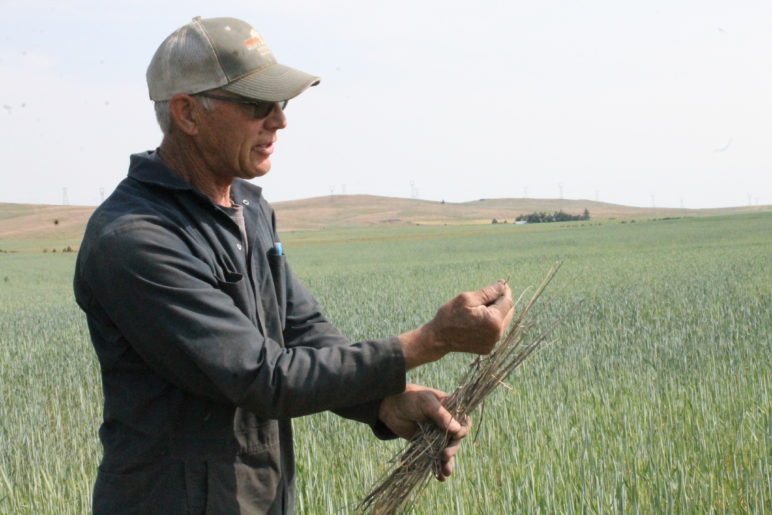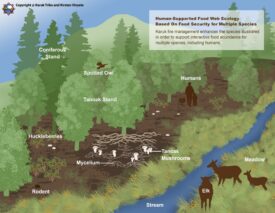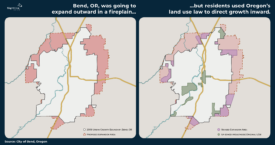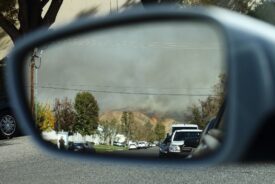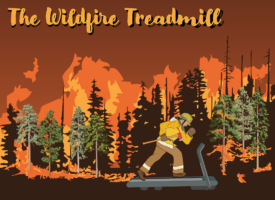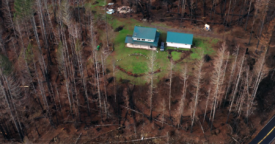Every winter of his childhood, Ron Juris remembers watching rivulets run down his family’s fields. They’d grow bigger with every storm throughout the winter and spring, each time carrying larger streams of soil down the slopes, as brown as chocolate milk. In the fall and spring, area windstorms would blow the soil away, at times making the air so thick that it became difficult to see.
The Juris family has been growing wheat in Klickitat County, Washington for four generations. There’s even a Juris Road winding between the fields, though Ron doesn’t know which Juris it’s named for. The family’s farm is located in Horse Heaven Hills, a rolling landscape stretching from south-central Washington into north-central Oregon. Horse Heaven Hills gets less than 12 inches of precipitation per year, making it one of the driest wheat-producing regions in the world.
Farmers have adapted to the dry environment, but those adaptations have come with a high cost to the soil. In Ron’s great-grandfather’s day, the cost was heavy erosion. In the early 1990s, farmers began to fight erosion by reducing their tillage—leaving the soil undisturbed rather than churning it throughout the year—relying instead on herbicides for weed control. Reduced tillage effectively combats erosion, keeping soil on the farm and out of the air and waterways; but increased herbicide use brings its own risks to soil, environmental, and public health. Now farmers in the area face a new challenge as the herbicides are increasingly ineffective in the face of superweeds.
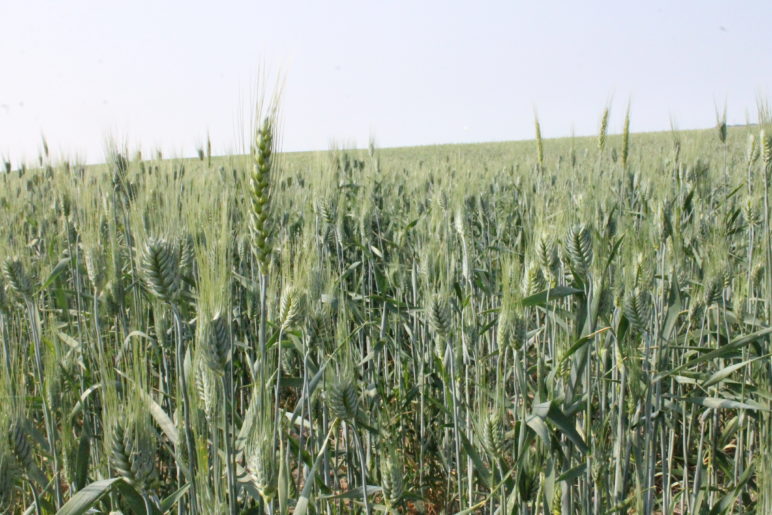
Wheatfields of Horse Heaven Hills, a region about 12 inches of precipitation each year—one of the driest regions in the world.
Since taking over the family farm 30 years ago, Ron has been a leader in conservation and one of the producers in the area most willing to experiment with new techniques to protect the soil on the 5,000 acres he farms, while continuing to coax wheat through the bone-dry summers. Today, he’s looking for a way out of the erosion-versus-herbicide bind.
A recipe for erosion
Cereal farmers across the inland Pacific Northwest frequently fallow their fields between crops, leaving them unplanted to allow the ground to soak up a year’s worth of rain and snow in preparation for the next planting. East of Horse Heaven Hills, where there is more moisture, farmers can wait two or three years between fallow periods, but in the driest areas, most farmers fallow their fields after every crop.
With no crop to compete with weeds, fallow fields are prime targets for the region’s most persistent invaders: Russian thistle, downy brome, wild oat grass, and others. To combat weeds during the fallow year, farmers in Ron’s great-grandfather’s time tilled the soil frequently to tear up weeds before they could steal the soil’s moisture. But tilling also ground the dirt into ever finer particles, making it easier for the area’s windstorms to carry it away.
Though fallow fields and intensive tilling made it possible for farmers to survive in this arid climate, these practices left the soil vulnerable to the area’s windstorms and heavy winter rains. Wheat country in the inland Pacific Northwest sees some of the worst wind and water erosion in the United States, with several tons of soil washing and blowing away per acre every year.
Stemming erosion
In the early 1990s, Ron became increasingly concerned about the soil he watched wash away each winter, and blow away every spring. As an experiment, he began leaving his fields undisturbed after harvest, throwing out the conventional wisdom that tilling is necessary to fend off weeds. Rather than churning crop residue back into the soil, he left remaining wheat stalks and roots in place to fortify the ground against the coming windstorms and pummeling rain.
He noticed an immediate difference: the rivulets in his first no-till year were smaller than any he’d seen, eventually all but disappearing from his fields. Since then he’s practiced conservation tillage, sometimes called reduced tillage, leaving crop residue in place and disturbing his soil as little as possible. Not only does the leftover residue form a protective coat over the ground, but the undisturbed soil also has time to build a stronger, stickier structure that’s harder for wind gusts to carry away.
Reduced tillage can cut soil loss by as much as 65 percent on a field, conserving soil, keeping the air cleaner, and protecting water quality by reducing sediment load in nearby waterways. It also saves weeks of work, eliminating as many as eight rounds of tilling throughout the year.
After the fallow year, Ron sows his next wheat crop using a specialized drill that plants seeds right through the previous year’s residue. The drills are expensive—upwards of $200,000—and Ron is one of the few farmers in the area who owns one. In fact, the price is one of the main obstacles to farmers interested in switching from conventional tillage. Most other reduced-till producers rent drills from neighbors, or from their local conservation districts, thanks to loan programs.
Reduced tillage is well-suited to low-rainfall areas, keeping grain yields similar to those under conventional tillage while allowing the undisturbed soil to absorb and retain water.
In the last 30 years, reduced tillage has become common in the inland Pacific Northwest, with over 70 percent of wheat farmers in the region now using some form of the method. No doubt this has played a part in reducing the region’s erosion over the last three decades. Still, the battle to keep soil on farms is far from won; Washington still has one of the highest wind and water erosion rates of any state in the country.
Other soil and climate benefits of reduced tilling
Leaving crop residue on a field does more than just hold the soil in place. It can also increase soil microbial diversity, increase nutrient availability and water absorption, and boost resistance to pests and disease. It also cuts down on heavy farm equipment use, saving producers money on diesel, and reducing on-farm emissions.
Globally, no- and reduced-till agriculture has received lots of attention as a strategy for mitigating the climate crisis by sucking carbon out of the atmosphere and sequestering it within the soil. Studies in the inland Pacific Northwest have found that converting conventionally tilled cropland to no-till could minimize soil carbon loss, or even sequester nearly a ton of carbon dioxide per hectare per year for at least a decade. Soil carbon storage varies with precipitation, baseline soil carbon content, and other factors. Still, according to this estimate, converting 15 percent of Washington cropland to no-till would be like taking 70,000 cars off the road each year.
These climate benefits are up for debate, though, as some scientists believe that no-till simply redistributes soil carbon rather than boosting it. Tillage churns crop residue deeper into the soil, while no-till leaves organic matter closer to the top. Studies based on shallow soil profiles may pick up the carbon gains near the surface while missing reductions at greater depths.
Reducing tillage alone may not boost soil carbon content, but it’s possible that doing it in conjunction with other farming practices, like adding cover crops, organic matter, and diversifying crop rotations, could influence carbon sequestration. Still, the links between increasing soil carbon and reductions in atmospheric carbon remain complex.
Battling the weeds
It’s July and Ron is in his dusty pickup, surveying a field he’s kept fallow for the last year. He plans to seed it with a new wheat crop in a couple of months. Things are looking good—he can tell the soil is moist beneath its thin upper crust—until he drives over a ridge and sees something that makes his heart sink: green.
It’s wild oat grass, one of several weeds that have developed a resistance to herbicides. It’s become what many people now call a superweed. Juris already sprayed the field twice this year—now he’ll need to spray a third time before planting. In Pacific Northwest wheat fields, this level of herbicide application has become common.
Without the plow to keep weeds down, cereal farmers turn to chemical weed management. Glyphosate, the chemical first sold commercially in RoundUp, is among the most commonly used herbicides. Since the early 1990s, Washington farmers have increased glyphosate application on their winter wheat fields by at least 2,000 percent, following national and global trends. It’s difficult to estimate how much of this increase is a direct result of changes in tillage practices, but that’s been at least one major contributing factor.
Increasing herbicide reliance in the region has encouraged a corresponding jump in herbicide-resistant weeds. It’s become an arms race: farmers apply ever greater amounts of herbicides to combat the stronger weeds. Rising herbicide application feeds the genetic selection process for more chemical-resistant weeds. In some cases, even seven times the maximum glyphosate label rate is no longer killing target weeds.
Herbicides pose risks to both human and environmental health. Though many weed scientists believe glyphosate is among the less toxic chemicals for weed control, and that its benefits outweigh the attendant risks, research links it with impacts on human reproductive and endocrine systems. Some studies show glyphosate and RoundUp can influence mechanisms of cancer cell propagation, though other studies find no connection. Whether glyphosate is a carcinogen remains a topic of hot debate, one that’s currently receiving lots of media attention due to a spate of high profile lawsuits.
In addition to its risks to human health, glyphosate can also have toxic impacts on soil organisms—from earthworms to mycorrhizal fungi—which boost crop yields and agricultural resilience. Beyond the farm, the herbicide negatively affects water quality and aquatic ecosystems, as well as reptiles, amphibians, and birds. Rates of microbial breakdown of glyphosate are heavily site-specific, though it can persist in the environment for months after it is applied.
Where to go from here?
Short wooden stakes poke up in seemingly random places across Ron’s wheat fields. Those are the experimental plots he’s given to researchers at Washington State University who are investigating new methods to fight the weeds. Though a few of the experiments are testing chemical solutions, others are going a different route. They are exploring means of weaning off herbicides by turning to biology. Diversifying crop rotations could build soil health and cover crops could control weeds via competition.
Ron is experimenting with new crop rotations—spring wheat, canola, peas, alfalfa—anything to break the wheat-fallow-wheat cycle the area’s soils have seen for decades. Though these other crops are typically less profitable, the break from wheat changes soil dynamics, making it more difficult for the weeds to settle in. So far he’s had only mixed success with the new crops.
Farmers elsewhere use cover crops to control weeds, with much-reduced herbicide application. Rather than leave a field fallow between plantings, fast-growing cover crops protect the soil from erosion and out-compete weeds for light and nutrients. But most farmers in Horse Heaven Hills fear this won’t work in their arid climate. Water is precious here, and conventional wisdom dictates that cover crops will use up the scarce moisture, leaving little for the wheat. Research on cover cropping in dry areas is relatively scarce and farmers are hesitant to give it a try.
Producers, like Ron, practicing conservation tillage have been leaders in soil stewardship. They’ve been willing to turn conventional farming wisdom on its head, finding a way to farm without the plow in order to fight erosion and preserve the soil. Now they face a new challenge and it’s time for the next leap forward. Cover cropping and diversifying plantings could be part of the next farming breakthrough in the inland Pacific Northwest. For now, these producers need research support to find a way out of their catch-22, one that preserves both their livelihoods and the region’s rich soils.
Thank you to Ron and Andy Juris for sharing their stories for this article, and to Ty Meyers, executive director of the Pacific Northwest Direct Seed Association, for his comments on a draft of this article. The Regional Approaches to Climate Change (REACCH) Farmer to Farmer Case Study Project also profiled Ron Juris. You can read that case study here.
Margaret Morales is the lead researcher for Sightline’s Farms and Forests program. She received her Master’s from The University of British Columbia’s Institute for Resources, Environment, and Sustainability where she was a Bridge Fellow focusing on issues of public health and the environment. If you’d like to contact Margaret or request an interview, please contact Communications Manager Anne Christnovich.
Note on methods: To calculate the percent increase in glyphosate use in Washington State from the early 1990s to present, this article uses data from the National Agriculture Statistics Service database. In the early 1990s, RoundUp was the only glyphosate-based herbicide available on the market. Since the patent on glyphosate expired in 2000, several new formulations of the chemical have become common. This article compares RoundUp use on Washington winter wheat crops in 1991 (24,000 pounds) with use of the isopropylamine salt formulation of glyphosate, the active ingredient in RoundUp, in 2017 (506,000 pounds). A second form of glyphosate—potassium salt—is now also applied to winter wheat crops in Washington, totaling an additional 243,000 pounds per year. That use is not included in this article’s calculation of an increase in glyphosate application over the last three decades.


